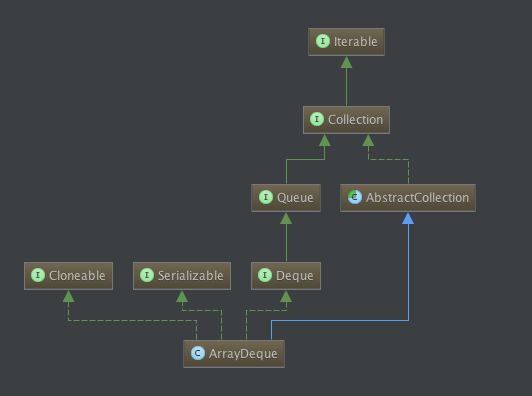java 集合-ArrayDeque
基本概念及实例
ArrayDeque类实现Queue接口。对于数组实现的Deque来说,数据结构上比较简单,只需要一个存储数据的数组以及头尾两个索引即可。由于数组是固定长度的,所以很容易就得到数组的头和尾,那么对于数组的操作只需要移动头和尾的索引即可。
- ArrayDeque并不是一个固定大小的队列 , 每次队列满了以后就将队列容量扩大一倍(doubleCapacity()),因此加入一个元素总是能成功 ,而且也不会抛出一个异常。也就是说ArrayDeque是一个没有容量限制的队列;
- 同样继续性能的考虑,使用System.arraycopy复制一个数组比循环设置要高效得多;
- ArrayDeque不可以存取null元素,因为系统根据某个位置是否为null来判断元素的存在;
- 当作为栈使用时,性能比Stack好;当作为队列使用时,性能比LinkedList好;
- 它们不是线程安全的;如果没有外部同步;
- 不支持多线程并发访问;
结构图(来源互联网)

实例1:实现栈
mport java.util.ArrayDeque;
import java.util.Deque;
public class StackbyArrayDeque <T>{
private Deque<T> stack=new ArrayDeque<>();
public void push(T v)
{
stack.addFirst(v);
}
public T pop()
{
return stack.removeFirst();
}
public T peek()
{
return stack.peekFirst();
}
}源码分析(原文请点击)
- 两个重要的索引:head和tail
// 第一个元素的索引
private transient int head;
// 下个要添加元素的位置,为末尾元素的索引 + 1
private transient int tail;
- 构造方法
public ArrayDeque() {
elements = (E[]) new Object[16]; // 默认的数组长度大小
}
public ArrayDeque(int numElements) {
allocateElements(numElements); // 需要的数组长度大小
}
public ArrayDeque(Collection<? extends E> c) {
allocateElements(c.size()); // 根据集合来分配数组大小
addAll(c); // 把集合中元素放到数组中
}3.分配合适大小的数组
private void allocateElements(int numElements) {
int initialCapacity = MIN_INITIAL_CAPACITY;
// 找到大于需要长度的最小的2的幂整数。
// Tests "<=" because arrays aren't kept full.
if (numElements >= initialCapacity) {
initialCapacity = numElements;
initialCapacity |= (initialCapacity >>> 1);
initialCapacity |= (initialCapacity >>> 2);
initialCapacity |= (initialCapacity >>> 4);
initialCapacity |= (initialCapacity >>> 8);
initialCapacity |= (initialCapacity >>> 16);
initialCapacity++;
if (initialCapacity < 0) // Too many elements, must back off
initialCapacity >>>= 1;// Good luck allocating 2 ^ 30 elements
}
elements = (E[]) new Object[initialCapacity];
}- 扩容
// 扩容为原来的2倍。
private void doubleCapacity() {
assert head == tail;
int p = head;
int n = elements.length;
int r = n - p; // number of elements to the right of p
int newCapacity = n << 1;
if (newCapacity < 0)
throw new IllegalStateException("Sorry, deque too big");
Object[] a = new Object[newCapacity];
// 既然是head和tail已经重合了,说明tail是在head的左边。
System.arraycopy(elements, p, a, 0, r); // 拷贝原数组从head位置到结束的数据
System.arraycopy(elements, 0, a, r, p); // 拷贝原数组从开始到head的数据
elements = (E[])a;
head = 0; // 重置head和tail为数据的开始和结束索引
tail = n;
}
// 拷贝该数组的所有元素到目标数组
private <T> T[] copyElements(T[] a) {
if (head < tail) { // 开始索引大于结束索引,一次拷贝
System.arraycopy(elements, head, a, 0, size());
} else if (head > tail) { // 开始索引在结束索引的右边,分两段拷贝
int headPortionLen = elements.length - head;
System.arraycopy(elements, head, a, 0, headPortionLen);
System.arraycopy(elements, 0, a, headPortionLen, tail);
}
return a;
}5.添加元素
public void addFirst(E e) {
if (e == null)
throw new NullPointerException();
// 本来可以简单地写成head-1,但如果head为0,减1就变为-1了,和elements.length - 1进行与操作就是为了处理这种情况,这时结果为elements.length - 1。
elements[head = (head - 1) & (elements.length - 1)] = e;
if (head == tail) // head和tail不可以重叠
doubleCapacity();
}
public void addLast(E e) {
if (e == null)
throw new NullPointerException();
// tail位置是空的,把元素放到这。
elements[tail] = e;
// 和head的操作类似,为了处理临界情况 (tail为length - 1时),和length - 1进行与操作,结果为0。
if ( (tail = (tail + 1) & (elements.length - 1)) == head)
doubleCapacity();
}
public boolean offerFirst(E e) {
addFirst(e);
return true;
}
public boolean offerLast(E e) {
addLast(e);
return true;
}6.删除元素
public E removeFirst() {
E x = pollFirst();
if (x == null)
throw new NoSuchElementException();
return x;
}
public E removeLast() {
E x = pollLast();
if (x == null)
throw new NoSuchElementException();
return x;
}
public E pollFirst() {
int h = head;
E result = elements[h]; // Element is null if deque empty
if (result == null)
return null;
// 表明head位置已为空
elements[h] = null; // Must null out slot
head = (h + 1) & (elements.length - 1); // 处理临界情况(当h为elements.length - 1时),与后的结果为0。
return result;
}
public E pollLast() {
int t = (tail - 1) & (elements.length - 1); // 处理临界情况(当tail为0时),与后的结果为elements.length - 1。
E result = elements[t];
if (result == null)
return null;
elements[t] = null;
tail = t; // tail指向的是下个要添加元素的索引。
return result;
}删除指定元素:
public boolean removeFirstOccurrence(Object o) {
if (o == null)
return false;
int mask = elements.length - 1;
int i = head;
E x;
while ( (x = elements[i]) != null) {
if (o.equals(x)) {
delete(i);
return true;
}
i = (i + 1) & mask; // 从头到尾遍历
}
return false;
}
public boolean removeLastOccurrence(Object o) {
if (o == null)
return false;
int mask = elements.length - 1;
int i = (tail - 1) & mask; // 末尾元素的索引
E x;
while ( (x = elements[i]) != null) {
if (o.equals(x)) {
delete(i);
return true;
}
i = (i - 1) & mask; // 从尾到头遍历
}
return false;
} private void checkInvariants() { // 有效性检查
assert elements[tail] == null; // tail位置没有元素
assert head == tail ? elements[head] == null :
(elements[head] != null &&
elements[(tail - 1) & (elements.length - 1)] != null); // 如果head和tail重叠,队列为空;否则head位置有元素,tail-1位置有元素。
assert elements[(head - 1) & (elements.length - 1)] == null; // head-1的位置没有元素。
}
private boolean delete(int i) {
checkInvariants();
final E[] elements = this.elements;
final int mask = elements.length - 1;
final int h = head;
final int t = tail;
final int front = (i - h) & mask; // i前面的元素个数
final int back = (t - i) & mask; // i后面的元素个数
// Invariant: head <= i < tail mod circularity
if (front >= ((t - h) & mask)) // i不在head和tail之间
throw new ConcurrentModificationException();
// Optimize for least element motion
if (front < back) { // i的位置靠近head,移动开始的元素,返回false。
if (h <= i) {
System.arraycopy(elements, h, elements, h + 1, front);
} else { // Wrap around
System.arraycopy(elements, 0, elements, 1, i);
elements[0] = elements[mask]; // 处理边缘元素
System.arraycopy(elements, h, elements, h + 1, mask - h);
}
elements[h] = null;
head = (h + 1) & mask; // head位置后移
return false;
} else { // i的位置靠近tail,移动末尾的元素,返回true。
if (i < t) { // Copy the null tail as well
System.arraycopy(elements, i + 1, elements, i, back);
tail = t - 1;
} else { // Wrap around
System.arraycopy(elements, i + 1, elements, i, mask - i);
elements[mask] = elements[0];
System.arraycopy(elements, 1, elements, 0, t);
tail = (t - 1) & mask;
}
return true;
}
}
7:获取元素
public E getFirst() {
E x = elements[head];
if (x == null)
throw new NoSuchElementException();
return x;
}
public E getLast() {
E x = elements[(tail - 1) & (elements.length - 1)]; // 处理临界情况(当tail为0时),与后的结果为elements.length - 1。
if (x == null)
throw new NoSuchElementException();
return x;
}
public E peekFirst() {
return elements[head]; // elements[head] is null if deque empty
}
public E peekLast() {
return elements[(tail - 1) & (elements.length - 1)];
}